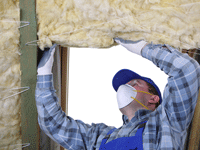
Attic
The Department of Energy recommends at least 13 inches of batt or blown-in insulation in the attic - and 16 inches for the most protection from heat transfer. As you inspect the attic, look in the corners and around the attic vents to find places where the insulating products are thinner and could cause heat to radiate into the attic and form ice dams on your roof after a snowfall.
Walls
The levels in your walls affect your home's comfort level, which you can check by taking off an electrical face plate and looking inside an exterior wall. For safety purposes, you should turn off the circuit breaker for that particular outlet.
Another way to check the walls is to ask an energy auditor or HVAC contractor who uses thermographic equipment to measure the thermal differences along your exterior walls. This equipment shows temperature differences as distinct colors. The easiest way to improve the insulating value of your walls is to use blown-in or expanding foam, both of which a contractor can do for you. Increasing it will help avoid frozen pipes during very cold weather.
Basement
If your basement ceiling joists are visible, you'll see any insulating materials. If not, you might be able to check them by removing a ceiling light fixture. Batt insulating rolls can be stapled to the joists and they come in varying widths to tuck tightly between the joists. If you do add it to the basement ceiling, you might insulate any exposed plumbing pipes, since the batts will block heat transfer from your first level to the basement.
If you'd like more information on increasing the insulation in your home, contact Rodenhiser Plumbing, Heating & Air Conditioning. We've provided outstanding HVAC services for the Route 495/128 area of Norfolk MA since 1928.
Image via Shutterstock.com